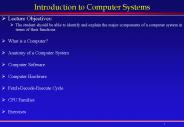Computer Fundamentals - PowerPoint PPT Presentation
1 / 18
Title:
Computer Fundamentals
Description:
Keyboard, monitor, system, scanners, mouse, etc. Microchips, motherboard, ... Input Hardware: Scanners. Text and graphics are digitized to become computer files. ... – PowerPoint PPT presentation
Number of Views:15
Avg rating:3.0/5.0
Title: Computer Fundamentals
1
Computer Fundamentals
2
A Computer Is a System
Data is entered into the computer
The data is processed by adding, subtracting, and
sorting
Becomes useful information
3
Example
Data for student registration
Registration requests are checked against the
lists (database), and if room is available, the
student is added to the class list
A schedule for the student is created.
4
Computer Components
- Hardware
- Equipment
- Keyboard, monitor, system, scanners, mouse, etc.
- Microchips, motherboard, ports
- Software
- Instructions
- Programs
- Hardware Software are required for the computer
to work.
5
Hardware System
Processing hardware is microprocessor (i.e. Intel
Pentium Processor)
- Input hardware include
- Keyboard
- Mouse
- Scanner
- Voice
- Output hardware includes
- Printer
- Screen
- Sound
Storage
6
Input Hardware Mouse
- As the mouse is moved, the cursor on the screen
mimics the mouse movement. - Types
- Ball motion of the ball in the mouse detected
by wheels within the mouse. - Gets dirty.
- Depends on smooth surface.
- Optical small camera replaces the ball.
- Stays clean.
- Can be used on any surface.
- Wireless - no wire connecting the mouse to the
computer.
7
Input Hardware Keyboards
- Text and commands are entered using the keyboard
- Specialized keys include
- Escape (ESC)
- Delete Backspace
- Number Lock (Num Lock)
- Arrow keys
- Caps Lock
- Function Keys
- Enter Key
- Types
8
Input Hardware Scanners
- Text and graphics are digitized to become
computer files. - Types
- Flatbed (most common)
- Handheld
9
Processing Hardware Microprocessors
- 2 types
- Intel architecture Used with IBM-compatible PCs
- Intel Pentium
- Celeron
- AMD
- Motorola Used with Macintosh computers
10
Microprocessors RAM
Storage (RAM) All data and instructions must be
loaded into RAM to be used by the microprocessor
Microprocessor (CPU) Adds, subtracts, sorts, etc.
Data instructions move back and forth
Hard Drive used for virtual RAM, and to store
files for later use.
11
Printers
- Inkjet
- small droplets of inks
- Color
- Versatile
- Inexpensive to buy, expensive to maintain
12
Laser
- Usually black and white (some color available but
rare) - High quality print
- Expensive to buy, less expensive to print
- Faster than inkjet
13
Hardware System Storage
- External or Secondary Storage
- Magnetic Disk
- Hard drive
- Floppy drive
- Zip Disk
- CD-ROM
- Internal or Primary
- RAM (Random Access Memory)
- Volatile
Storage
2 Types of Storage
14
Units of Storage
- Size
- Bit (binary digit) 0 or 1
- Byte 8 bits 1 character
- K (kilobyte) 1,024 bytes
- Mb (megabyte) 1 million bytes
- Gb (gigabyte) 1 billion bytes
15
How Much Can a Computer Hold?
- Primary storage (RAM)
- Units of 32 megabytes (Mb)
- Example 32 Mb, 64 Mb, 128 Mb
- The higher the number, the more the computer can
process at once - Secondary storage (disk or CD-ROM)
- Hard drives gigabytes
- Floppy disks 1.4 Mb
- Zip disks 100 Mb 250 Mb
- CD-ROM approximately 400 Mb
16
Computer Software
- System Software
- Operating System instructions that make the
hardware work - Microsoft Windows for IBM-Compatible PCs
- Macintosh OS for Macintosh computers
- Others Unix, Linux, etc. not as common
- Utilities
- Formatting
- Housekeeping
17
Computer Software (continued)
- Application Software
- Word Processing Word, WordPerfect, Works, etc.
- Graphics editing
- Web authoring
- Any software that a specific purpose or
application.
18
How to Format a Disk
- PC
- Right-click on My Computer on the desktop
- Click Explore
- Right-click on the disk drive where the disk you
need to format is contained usually the floppy
disk drive (usually drive A) or the Zip Disk - Click Format































